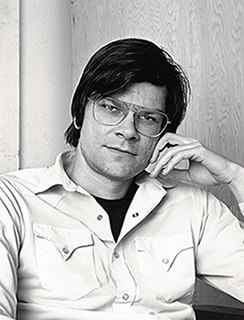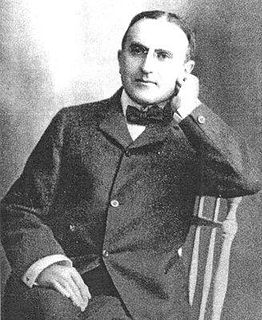
Robert Smithson was an American artist known for sculpture and land art who often used drawing and photography in relation to the spatial arts. His work has been internationally exhibited in galleries and museums and is held in public collections including the Museum of Modern Art, New York, the Smithsonian American Art Museum, Solomon R. Guggenheim Museum, New York, the Tate Modern, London, the Whitney Museum of American Art, New York, among others. He was one of the founders of the Land Art movement whose best known work is the Spiral Jetty.

Spiral Jetty is an earthwork sculpture constructed in April 1970 that is considered to be the most important work of American sculptor Robert Smithson. Smithson documented the construction of the sculpture in a 32-minute color film also titled Spiral Jetty.

Samuel Newhouse was a Utah entrepreneur and mining magnate.

The Oquirrh Mountains is a mountain range that runs north-south for approximately 30 miles (50 km) to form the west side of Utah's Salt Lake Valley, separating it from Tooele Valley. The range runs from northwestern Utah County–central & eastern Tooele County, to the south shore of the Great Salt Lake. The highest elevation is Flat Top Mountain (Utah) at 10,620 ft. The name Oquirrh was taken from the Goshute word meaning "wood sitting."

Kennecott Utah Copper LLC (KUC), a division of Rio Tinto Group, is a mining, smelting, and refining company. Its corporate headquarters are located in South Jordan, Utah. Kennecott operates the Bingham Canyon Mine, one of the largest open-pit copper mines in the world in Bingham Canyon, Salt Lake County, Utah. The company was first formed in 1898 as the Boston Consolidated Mining Company. The current corporation was formed in 1989. The mine and associated smelter produce 1% of the world's copper.

Copperton is a metro township in Salt Lake County, Utah, United States, located at the mouth of Bingham Canyon, about 17 miles southwest of Salt Lake City. The metro township boundaries include a smaller area than that of both the former CDP and the former township. Much of the town is included in the Copperton Historic District, which is listed on the National Register of Historic Places.

Ruth is a census-designated place (CDP) in White Pine County, Nevada, United States. Founded in 1903, it had a population of 440 at the 2010 census.
Harkers Canyon is located 20 km (12 mi) west-southwest of downtown Salt Lake City, in Salt Lake County, Utah, USA. The canyon empties into the Salt Lake Valley from its origin in the Oquirrh Mountains. The canyon is oriented primarily from southwest to northeast, with the middle third of the canyon descending from west to east. Harkers Canyon and surrounding land are owned and managed by the Kennecott Utah Copper Corporation and has been mined for copper.

The Bingham Canyon Mine, more commonly known as Kennecott Copper Mine among locals, is an open-pit mining operation extracting a large porphyry copper deposit southwest of Salt Lake City, Utah, in the Oquirrh Mountains. The mine is the largest man-made excavation, and deepest open-pit mine in the world, which is considered to have produced more copper than any other mine in history – more than 19 million tons. The mine is owned by Rio Tinto Group, a British-Australian multinational corporation. The copper operations at Bingham Canyon Mine are managed through Kennecott Utah Copper Corporation which operates the mine, a concentrator plant, a smelter, and a refinery. The mine has been in production since 1906, and has resulted in the creation of a pit over 0.75 miles (1,210 m) deep, 2.5 miles (4 km) wide, and covering 1,900 acres. It was designated a National Historic Landmark in 1966 under the name Bingham Canyon Open Pit Copper Mine. The mine experienced a massive landslide in April 2013 and a smaller slide in September 2013.

Daniel Cowan Jackling , was an American mining and metallurgical engineer who pioneered the exploitation of low-grade porphyry copper ores at the Bingham Canyon Mine, Utah.

Bingham Canyon was a city formerly located in southwestern Salt Lake County, Utah, United States, in a narrow canyon on the eastern face of the Oquirrh Mountains. The Bingham Canyon area boomed during the first years of the twentieth century, as rich copper deposits in the canyon began to be developed, and at its peak the city had approximately 15,000 residents. The success of the local mines eventually proved to be the town's undoing, however: by the mid-twentieth century the huge open-pit Bingham Canyon Mine began encroaching on the land of the community, causing residents to relocate. By the 1970s, almost the entirety of the town had been devoured by the mine, and the few remaining residents voted to disincorporate and abandon the community. No trace of Bingham Canyon remains today.
Louis S. Cates was an American mining engineer and businessman. He was president of Phelps Dodge from 1930-1947.

Copper mining in the United States has been a major industry since the rise of the northern Michigan copper district in the 1840s. In 2017 the United States produced 1.27 million metric tonnes of copper, worth $8 billion, making it the world's fourth largest copper producer, after Chile, China, and Peru. Copper was produced from 23 mines in the US. Top copper producing states in 2014 were Arizona, Utah, New Mexico, Nevada, and Montana. Minor production also came from Idaho, and Missouri. As of 2014, the US had 45 million tonnes of known remaining reserves of copper, the fifth largest known copper reserves in the world, after Chile, Australia, Peru, and Mexico.

Gold mining in the United States has taken place continually since the discovery of gold at the Reed farm in North Carolina in 1799. The first documented occurrence of gold was in Virginia in 1782. Some minor gold production took place in North Carolina as early as 1793, but created no excitement. The discovery on the Reed farm in 1799 which was identified as gold in 1802 and subsequently mined marked the first commercial production.

The Eagle Mine is a small, high-grade nickel mining and copper mining project owned by Lundin Mining. The mine is located on the Yellow Dog Plains in the Upper Peninsula of Michigan in the United States. Eagle is the only primary nickel mining project in the United States. The mine began production in fall 2014 and is expected to produce 360 million pounds of nickel, 295 million pounds of copper and small amounts of other metals over its eight-year mine life.

Lark is a ghost town located 4 miles (6.4 km) west of Herriman in the Oquirrh Mountains of southwest Salt Lake County, Utah, United States. Lark was the location of several copper mines.
The Kennecott Utah Copper rail line was an electric railroad in Salt Lake County, Utah. It was managed by the Kennecott Utah Copper Corporation and connected the Bingham Canyon Mine with its smelter at Garfield. The rail line has been replaced by a system of conveyors and a 17-mile-long (27 km) slurry pipeline. Current rail operations by Kennecott Utah Copper LLC only occur in the area of the smelter, on a remnant of what was a vast rail network.

The Robinson Mine is a porphyry copper deposit located at Ruth, White Pine County, Nevada, in the Egan Range, 4 miles (6.4 km) west of Ely. The mine comprises three large open pits: Liberty, Tripp-Veteran and Ruth. The ore is extracted using conventional surface methods, and is then processed into a copper-gold concentrate, and a molybdenum concentrate in a concentrating plant. Since 2012 the mine has been owned and operated by Polish copper miner KGHM Polska Miedź S.A.
Autonomous Solutions, Inc. was founded in 2000 as a spinoff from Utah State University and is headquartered in Petersboro, Utah. Autonomous Solutions manufactures an OEM/vendor independent automation technology that retrofits to existing equipment. The system uses GPS, radio, and software technologies to create a fully autonomous vehicle. ASI has installations in the mining, farming, automotive, and military industries.

The International Smelting and Refining Company was a subsidiary of Anaconda Copper which operated primarily out of the International Smelter near Tooele, Utah. The International Smelter began operation in 1910 as a copper producer handling ores from Bingham Canyon and was expanded into a lead smelting operation in 1912. Copper smelting finished at International in 1946, and the lead smelter shut down in January 1972. The closure of the smelter would lead to the associated Tooele Valley Railway to be shut down ten years later in 1982. The company also handled several other Anaconda owned interests. After the shut down of several of the International Smelting sites, environmental reclamation has been performed by Anaconda Copper's successor company ARCO and the EPA Superfund program.
















